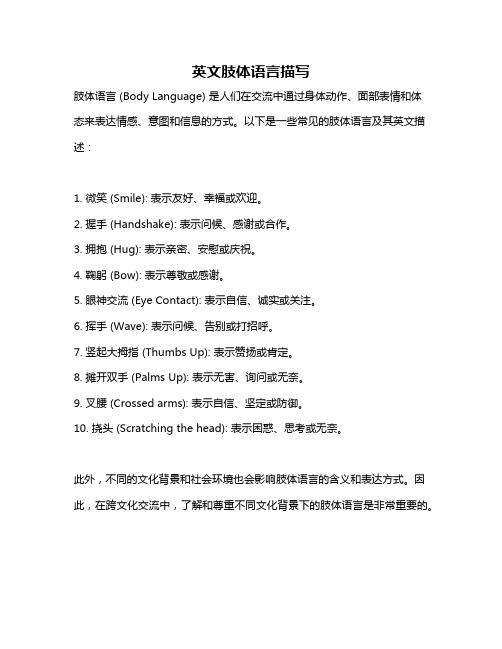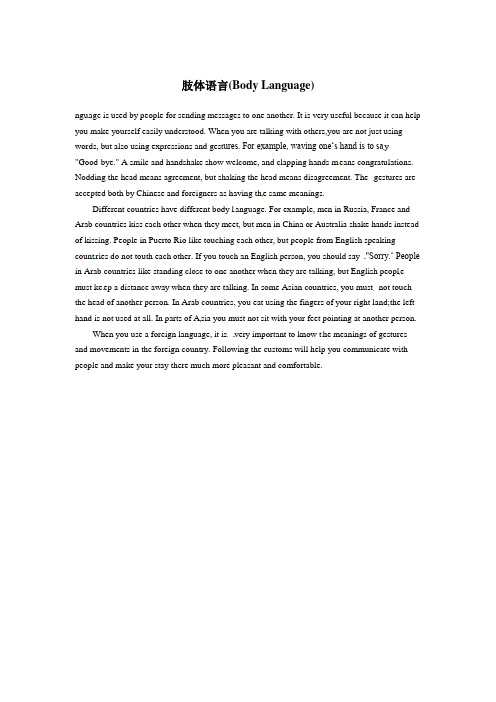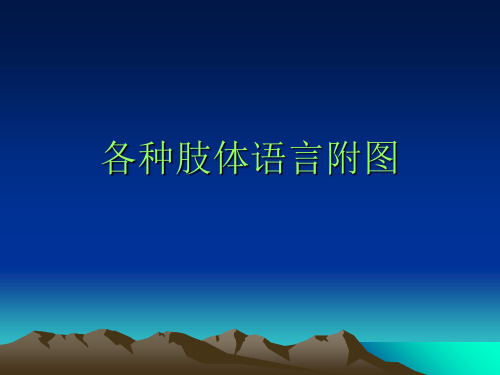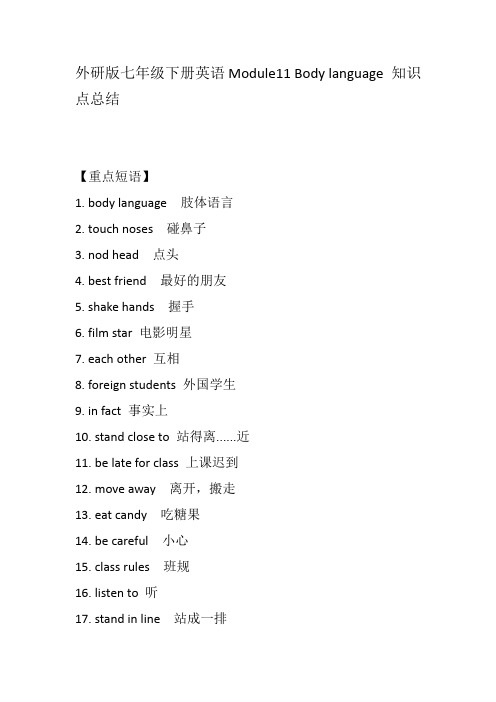Body language肢体语言
英文肢体语言描写

英文肢体语言描写
肢体语言 (Body Language) 是人们在交流中通过身体动作、面部表情和体
态来表达情感、意图和信息的方式。
以下是一些常见的肢体语言及其英文描述:
1. 微笑 (Smile): 表示友好、幸福或欢迎。
2. 握手 (Handshake): 表示问候、感谢或合作。
3. 拥抱 (Hug): 表示亲密、安慰或庆祝。
4. 鞠躬 (Bow): 表示尊敬或感谢。
5. 眼神交流 (Eye Contact): 表示自信、诚实或关注。
6. 挥手 (Wave): 表示问候、告别或打招呼。
7. 竖起大拇指 (Thumbs Up): 表示赞扬或肯定。
8. 摊开双手 (Palms Up): 表示无害、询问或无奈。
9. 叉腰 (Crossed arms): 表示自信、坚定或防御。
10. 挠头 (Scratching the head): 表示困惑、思考或无奈。
此外,不同的文化背景和社会环境也会影响肢体语言的含义和表达方式。
因此,在跨文化交流中,了解和尊重不同文化背景下的肢体语言是非常重要的。
肢体语言 body language

肢体语言(body language)是指能够传递某种特定信息的面部表情、手势语,以及其他身体部位的动作等等。
它在人际交往过程中起着非常重要的作用。
由于社会的发展,国与国之间的交流不断加强,西方的许多肢体语言在我国也已经被认同,还有一些被普遍适用。
比如:西方人往往指胸口来表示“我”。
大拇指朝上,表示“好”;但大拇指朝下则表示“坏,糟透了”。
还有用大拇指指尖与食指指尖相接成O形,伸直其余三个指头,表示OK,即“正常”、“顺利”、“没问题”。
伸出食指和中指成V形,表示victory(胜利)。
如果招手示意别人过来,他们是伸出手,掌心朝上,捏拢四指,前后弯动食指。
当然,在中国和西方国家中,肢体语言其含义也存在不同程度上的差异。
不过,很多肢体语言表达的含义还是一致的,比如,点头表示:同意或者表示明白了,听懂了;眉毛上扬表示:不相信或惊讶;避免目光接触意味着:冷漠,逃避,不关心,没有安全感,消极,恐惧或紧张等;摇头表示:不同意;鼓掌:赞成或高兴等等,但是在这里,我们主要通过分类来说明,在不同的文化背景下,不同的肢体语言在不同程度上所存在的差异,了解从中体现出来的文化差异,从而提高我们学习语言的兴趣。
一、动作一样,意义不同(the same action,different meaning)。
如下例:1. 跺脚(stamp one’s foot):在中国人看来,表示气愤,恼怒,灰心,悔恨。
比如说:气得直跺脚。
而它的英文含义则是不耐烦,比如:give a stamp of impatience(不耐烦得跺脚)。
2. 目不转睛地看(look with fixed gaze):其中文含义是:好奇;有时是惊讶。
比如,孩子们目不转睛地盯着公园里的猴子;他目不转睛的看着科幻书上的飞碟等等。
而这个短语的英文含义则是不礼貌;使人发窘;不自在。
比如:Under his intense gaze she felt uncomfortable.(他目不转睛地看着她,使她觉得很不自在。
体态语言

体态语言引言肢体语言(body language)也称体态语言,是人类借助和利用自己的面部表情、手势动作、身体姿态的变化来表达和传递思想感情的方式。
运用自己的体态来表情达意几乎是人类自身的一种本能,因为它简便、迅捷、直观,在现实生活中的使用极其广泛,而且有时更能无声胜有声地巧妙表达信息并留给对方更大的想象空间。
它可以加强、补充有声语言表达,并使语言信息具体化。
1肢体语言具有信息量大、连贯性和变化性强、以及可靠程度高的特点。
原因有以下主要三方面:(1)肢体语言可以进行多方面、多层次的信息交流。
一个人的眼神、服饰、手势、身姿、距离、音调、节奏等都可以同时传输。
使对方能同时、多方面、多渠道地接受多种信息。
(2)交际双方只要处于视听范围内,双方之间的肢体信息交流就能不断地进行。
交谈者的面部表情、手势动作、身体所处的位置都在不断变化着,这些变化都可以通过视觉传递给对方,传递连贯性和变化性的信息。
(3)肢体语言多数是人们在相对无意识状态下显示出来的,大多都是实际心态的体现,虚假成分较少,增强了交流信息的真实性和可靠性。
2学习肢体语言在跨文化交际中的必要性和重要性“跨文化交际”的英文名称是cross-cul-tural communication或intercultural communica-tion,指的是不同文化背景的人之间所发生的相互作用。
由于不同的民族所处的生态、物质、社会及宗教等环境不同,各自的语言环境便产生了不同的语言习惯、社会文化、风土人情等诸多语境因素,因而在不同的文化中,肢体语言的意义也不完全相同。
跨文化交际研究的基本内容之一就是非语言交际,而肢体语言又是非语言交际的重要内容。
近年来,随着改革开放步伐的加快,特别是我国加入WTO 以来,对外交往日益频繁,国与国之间的交流越来越广泛,国际互联网的开通使更多的人足不出户便涉及到跨文化交际。
因此,在跨文化交际中,如果肢体语言信息处理不好就会产生误解。
高中英语 肢体语言(Body Language)作文素材

肢体语言(Body Language)nguage is used by people for sending messages to one another. It is very useful because it can help you make yourself easily understood. When you are talking with others,you are not just using words, but also using expressions and gest ures. For example, waving one‘s hand is to sa y "Good-bye." A smile and handshake show welcome, and clapping hands m eans congratulations. Nodding the head means agreement, but shaking the head means disagreement. The gestures are accepted both by Chinese and foreigners as having th e same meanings.Different countries have different body language. For example, men in Russia, France and Arab countries kiss each other when they meet, but men in China or Australia shake hands instead of kissing. People in Puerto Rio like touching each other, but people from English speaking countries do not touth each other. If you touch an English person, you should say "Sorry.‘ People in Arab countries like standing close to one another when they are talking, but English peopl e must keep a distance away when they are talking. In some Asian countries, you must not touch the head of another person. In Arab countries, you eat using the fingers of your right land;the left hand is not used at all. In parts of Asia you must not sit with your feet pointing at another person.When you use a foreign language, it is very important to know the meanings of gestures and movements in the foreign country. Following the customs will help you communicate with people and make your stay there much more pleasant and comfortable.。
体态语

体态语词语:体态语注音:tǐ tài yǔ英文:body language释义:又称“肢体语言”。
是用身体动作来表达情感、交流信息、说明意向的沟通手段。
包括姿态、手势、面部表情和其他非语言手段,如点头、摇头、挥手、瞪眼等。
也是由人的面部表情、身体姿势、肢体动作和体位变化而构成的一个图像符号系统,常被认为是辨别说话人内心世界的主要根据,是一种人们在长期的交际中形成的一种约定俗成的自然符号。
但又与文化背景有一定关系。
如在印度,点头表示不同意,摇头表示同意。
体态语的概述提到交流,我们自然会想到语言,即我们每天说的不计其数的话。
但是,除了有声语言,还有一种对我们日常的交流做出了巨大贡献的身体语言──体态语。
体态语是一种表达和交换信息的可视化(有的伴声)符号系统,它由人的面部表情、身体姿势、肢体动作和体位变化等构成。
或者通俗地讲,当人体动作能够传递相关信息时,这些动作有了语言的功能,就成为体态语了。
在现实生活中,体态语使用极其广泛,而且有时更能无声胜有声地巧妙表达信息,同时留给对方更大的想象空间。
心理学家得出一个有趣的公式:一条信息的表达=7%的语言+38%的声音+55%的人体动作。
这表明,人们获得的信息大部分来自视觉印象。
因而美国心理学家艾德华·霍尔曾十分肯定地说:“无声语言所显示的意义要比有声语言多得多。
”人类的体态语具有一定的共性,语言不通、地域不同、文化相异的人们可以通过体态语进行一定程度上的有效交流。
然而,共性的体态语主要是指一些先天性动作(如欢乐之笑,痛苦之哭)和自发动作(如双臂抱胸,双腿交叉等),而更多的体态语却是后天习得的,根植于本民族的历史文化传统和社会宗教环境中,从而具有了各自的民族特性,自然而然体态语的文化差异就产生了。
随之在跨文化交际中,可能会因为体态语的差异而产生误解。
体态语特征和功能体态语虽然是一种无声语言,但它同有声语言一样也具有明确的含义和表达功能,有时连有声语言也达不到其效果,这就是所谓的“此时无声胜有声”。
各种肢体语言附图 ppt课件

各种肢体语言附图
• 扬起眉毛 把玩儿柱状物
• 嘴唇微启 摸脸
• 立正站立 瞳孔放大
• 整理着装 脸颊绯红
• 仰面与整理头发 暴露手腕
• 窥视
扭动臀部
• 盘腿而坐
眼睛斜视
• 整理领带
摸喉咙
• 拇指插向腰带
各种肢体语言附图
• 定时(每天至少15分钟) • 随地(社交场合、电视关掉声音) • 印证和总结 • 应用
各种肢体语言附图
图1为充满优越感和自信的姿势,2,3为消极情绪,自我控制,手越往上程度 月强。
各种肢体语言附图
霸道的姿势, 图3为隐藏的 图5为消极和 带有优越感 图6为对他人 不敬
各种肢体语言附图
说谎或需要安慰。
各种肢体语言附图
各种肢体语言附图
自责1轻度2深度1开朗、随遇而安
各种肢体语言附图
说话快速 、冒汗 、大口吸气 、过份友善 、 表现犹豫 、说话离题 、怕问细节
各种肢体语言附图
各种肢体语言附图
各种肢体语言附图
各种肢体语言附图
• 通常情况下,如果一个人再回忆某件事情的时候,他的眼睛会自然的向左移 动,如果一个人在酝酿、策划或编造一件事情时,他的眼球会不自觉的向右 侧移动。
各种肢体语言附图
• 摊开手掌表示坦诚
各种肢体语言附图
各种肢体语言附图
各种肢体语言附图
各种肢体语言附图
对某些事物抱有期待,而且这种期待是饱含自信的。
各种肢体语言附图
失望的姿势,正在克制一种消极的态度。手的高度与转变难度成正比。
各种肢体语言附图
表示自信和无所不知,1是谈话和发表意见2是倾听谈话。
• 1、在耳朵部位搔痒痒或轻揉耳朵——说明对方已不想再听你说下去。 • 2、用手指轻轻触摸脖子——说明对方对你说的持怀疑或不同意态度。 • 3、把手放在脑袋后边——说明对方有意辩论。 • 4、用手挡住嘴或稍稍触及嘴唇或鼻子——说明对方想隐藏内心的真
跨文化交际视角下的中西方肢体语言差异

跨文化交际视角下的中西方肢体语言差异姓名:XX 学院:外国语学院专业:英语年级:2009级学号:XXXXXX摘要肢体语言(body language)又称身势语言,是表示使用身体运动或动作来代替或辅助声音、口头言语或其他交流方式进行交流的一种方式的一个术语。
其之所以能够被称之为语言,主要在于它的信息通报性。
肢体语言和我们所学习的语言一样,它作为一种特殊的语言也是不可被忽视的文化的一部分。
它之所以具有着不可忽视的作用是因为它能够在学习和运用语言的过程中通过肢体的不同动作把我们想要表达出的话语以及内部实质意义更为深刻鲜明的表现出来,肢体语言能够更好地促进语言的交流,我们都知道,不论是以中国为代表的东方国家还是以欧美为代表的西方国家都有着肢体语言的存在,除了一些世界公认的肢体语言以外,不同的国家肢体语言还有着其不同的语言内涵,了解东西方不同的肢体语言有助于我们更为深入地了解西方文化,更好的增进我们语言的进修。
目录肢体语言的定义,重要性Ⅱ肢体语言的分类A :表情语言B :动作语言C : 体态语言Ⅲ影响跨文化交流中肢体语言的因素A:语言习惯B: 风俗习惯C:价值观Ⅳ正确理解中西方肢体语言的区别和运用A:动作一样,意义不同B:意义相同,动作有差异C:只存在于美国文化中的动作D:只存在于中国文化中的动作E:对一些常见的肢体语言的理解关键词:肢体语言、跨文化交际、如何运用正文Ⅰ肢体语言的定义,重要性肢体语言 (body language)也称体态语言,是人类借助和利用自己的面部表情、手势动作、身体姿态的变化来表达和传递思想感情的方式。
运用自己的体态来表情达意几乎是人类自身的一种本能,因为它简便、迅捷、直观,在现实生活中的使用极其广泛,而且有时更能无声胜有声地巧妙表达信息并留给对方更大的想象空间。
Ⅱ肢体语言的分类1.面部表情语言(facial expression language)在跨文化交流中,面部表情语言指的是在交流的过程中通过面部的一系列动作,来传达出我们内心的真实想法,不同国家的人民之间存在着语言障碍,但是通过面部的千变万化的表情我们可以相互了解对方的意愿,他的喜、怒、哀、乐,悲、恐、惊。
高考英语一轮复习 话题 肢体语言(Unit 4 Body language)

入舵市安恙阳光实验学校话题19 肢体语言(Unit 4 Body language)晨读背诵话题单词1. apparent 【əˈpærənt】 adj. 明显的 2. facial 【ˈfeɪʃ(ə)l】 adj. 面部的3. impression 【ɪmˈpreʃ(ə)n】 n. 表情4. contact 【ˈkɒntækt】 n. 接触5. approach 【əˈprəʊtʃ】 v. 靠近6. relationship 【rɪˈleɪʃənʃɪp】 n. 关系7. gesture 【ˈdʒestʃə(r)】 n. 手势 8. misunderstand 【mɪsʌndəˈstænd】 v. 误解9. unfair 【ʌnˈfeə(r)】 adj. 不公正的;不公平的 10. avoid 【əˈvɒɪd】 vt. 避免;消除11. ahead 【əˈhed】 adv. 在前;向前;提前 12. manage 【ˈmænɪdʒ】 vt. & vi. 做成(某事);管理13. occur 【əˈkə:】 vi. 发生;出现 14. firm 【fɜːm】 adj. (动作)稳定而有力的;牢固的15. fold 【fəʊld】 vt. 折叠;合拢;抱往 16. bend 【bend】 vt.vi. & n. 弯曲;专心于17. focus 【ˈfəʊkəs】 n. 中心;焦点 18. opposite 【ˈɒpəzɪt】 prep. 相反的19. interpret 【ɪnˈtɜːprɪt】 v. 诠释 20. sensitive 【ˈsensɪtɪv】 adj. 敏感的话题短语1.give/lend sb.a hand 给某人帮助 2.get through 通过;度过;到达3.rest on停放;依靠 4.greet sb.with通过……向某人问候5.hold up举起;拿起;举出6.ahead of (在空间或时间上比某人、物)更前;更早7.in order 按顺序,整齐 8.make a face 做鬼脸;扮怪相9. the eye contact 目光的接触 10. means of communication 交流的方式11. be tied to 与……有联系 12. express one’s feelings 表达某人的情感13. convey messages 传达信息 14. facial expression 面部表情15. an aspect of……的一个方面 16. communicate with与……交流话题句子1. There are also differences as to how often we touch each other, how close we stand tosomeone we are talking to , and how we act when we meet or part. 在我们互相触摸的频率上,在我们站立谈话的距离上,在我们见面分手的礼仪上,也都存在着许多不同之处。
英语中的肢体语言bodylanguage

英语中的肢体语言b o d y l a n g u a g e -CAL-FENGHAI.-(YICAI)-Company One1英语中的肢体语言英美人的点头,可以表示多种意思。
to nod consent点头表示同意。
to nod one's farewell点头表示告别to nod as a sign of agreement or as a familiar greeting点头表示赞同或打招呼Examples:He gave me a nod as he passed.他走过时向我点头。
He nodded me into the room.他点头示意要我进房间。
to hold one's head high昂首挺胸(表示趾高气扬)to shake one's fist挥动拳头(表示威胁)to shake one's head摇头(表示不知道)Example:He shook his head in answer to my question.他以摇头来回答我的问题。
to show a V sign由食指和中指构成字母“V”,而“V”是victory的第一个字母。
因此,这一手势是祝愿胜利或庆祝胜利之意。
to wink at a person向某人眨眼睛Example:Father winked at Dick as a sign for him to keep still.父亲向狄克眨眼睛,叫他不要动。
to shrug one's shoulders耸耸肩膀(表示冷淡或怀疑)to make a face面部露出厌恶的表情Example:Every time I mentioned taking a swim in the lake he made a face.我每次提出到湖里游泳,他就做出厌恶的表情。
to keep (or have) one's fingers crossed把中指叠在食指上交叉着,作十字状。
body language的概念

体态语言是一种非语言性的交流方式,它通过肢体动作、姿态、面部表情和眼神等方式传达信息和情感。
在人类交流中,体态语言占据着至关重要的地位,有时甚至比口头语言更能表达真实的情感和意图。
在本篇文章中,我将以从简到繁的方式,深入探讨体态语言的概念,以便我能更深入地理解。
1. 体态语言的基本概念体态语言是指人们在交流中通过身体动作和姿势来传递信息和情感的方式。
它包括肢体动作、姿态、面部表情和眼神等各种元素。
体态语言通常是不言而喻的,它能够传达出一个人的情绪、态度、自信心以及与他人的关系等方面的信息。
在人际交往和社交场合中,体态语言往往能起到比口头语言更直接、更真实的作用。
2. 体态语言的重要性体态语言在人际交往中扮演着重要的角色。
研究表明,有时候人们更倾向于相信对方的体态语言,而不是他们所说的话。
学会观察和运用体态语言可以帮助人们更好地理解他人,并且提高自己在交流中的效果。
体态语言在谈判、领导力和演讲等方面也具有重要意义,它能够帮助人们更好地表达自己的意图和观点,增强说服力和影响力。
3. 体态语言的元素和解读体态语言包括多个元素,每个元素都能够传递出丰富的信息。
一个人的手势可以显示出他的自信程度;面部表情可以表达出他的情绪状态;眼神可以透露出他的真诚度等等。
通过观察这些元素,并结合具体的情境和背景,人们可以解读出对方想要传达的信息和意图。
4. 体态语言的个人观点和理解在我看来,体态语言是一种极其重要的交流方式,它能够帮助人们更好地理解他人,同时也能够增强自己在交流中的表达能力。
我认为,学会观察和运用体态语言对于个人成长和职业发展都具有重要意义,因为它不仅能够改善人际关系,还能够帮助人们更好地表达自己的意图和观点。
总结回顾:通过以上的探讨,我们更深入地了解了体态语言的重要性和作用。
体态语言是一种非常重要的交流方式,它通过肢体动作、姿态、面部表情和眼神等方式传递信息和情感。
在人际交往和职业发展中,掌握观察和运用体态语言的技巧将会带来巨大的好处。
body language

手势语(sign language )是体态语的一种。
体态语(body language )包括眼神、走路姿势、站立的姿势以及手势等等。
体态语十分丰富,可以表达各种思想感情,并且不同的文化有着不同的体态语。
下面是一些常见的手势语在不同文化中的含义:1. 翘大拇指(thumb )。
在中国,翘大拇指表示“好”,用来称赞对方干得不错、了不起、高明、这个意思在世界上许多国家都是一样的。
英美人伸大拇指,向上翘,意为“ It's good. ”或“ It's OK. ”。
伸大拇指,向下翘,意为“ It's bad. ”或“ I don't agree it. ”。
但是在一些国家还有另外的意思。
比如,在日本,它还表示“男人”、“你的父亲”、“最高”;在韩国,还表示“首领”、“自己的父亲”、“部长”和“队长”;在澳大利亚、美国、墨西哥、荷兰等国,则表示“祈祷命运”;到了法国、印度,在拦路搭车时可以使用这一手势;在尼日利亚,它又表示对远方亲人的问候。
此外,一些国家还用这一手势指责对方“胡扯”。
2. 将拇指和食指(forefinger )弯曲合成圆圈,手心向前。
这个手势在美国表示“ OK ”;在日本表示钱;在拉丁美洲则表示下流低级的动作。
3. 用食指点别人。
这在欧美国家是很不礼貌的责骂人的动作。
英美人把大拇指和食指组成圆,其余三指伸直,意为“ Excellent. ”4. 伸出食指。
在美国表示让对方稍等;在法国表示请求对方回答问题;在缅甸表示请求,拜托;在新加坡表示最重要的;在澳大利亚则表示“请再来一杯啤酒”。
5. 伸出食指和中指(middle finger )做V 字状。
“ V ”是英文victory 和法文victore (胜利)的第一个字母,故在英国、法国、捷克等国此手势含有“胜利”之意。
但在塞尔维亚语中这一手势代表“英雄气概”,在荷兰语中则代表“自由”。
6. 食指弯曲:这一手势在中国表示“ 9 ”;在日本表示小偷,特别是那些专门在商店里偷窃的人及其偷窃行为;在泰国、新加坡、马来西亚表示死亡;在墨西哥则表示钱或询问价格及数量的多少。
肢体语言的英文作文80

肢体语言的英文作文80英文回答:Body Language: A Window to the Soul.Body language is a form of non-verbal communicationthat conveys messages through body movements, gestures, and facial expressions. It is an important aspect of human interaction as it can reveal a person's thoughts, feelings, and intentions. Understanding body language can help us improve our communication skills, build rapport with others, and make more informed decisions.Body language can be expressed through various channels:Facial expressions: The face is the most expressivepart of the body, capable of conveying a wide range of emotions. For example, a smile indicates happiness or friendliness, while a frown suggests sadness or disapproval.Eye contact: The way we look at someone can convey interest, attention, or avoidance. Maintaining appropriate eye contact is essential for effective communication and building trust.Gestures: Hands and arms are frequently used to emphasize words, express emotions, or indicate direction. For instance, a raised fist can symbolize anger or aggression, while open palms convey honesty or sincerity.Posture: The way we stand or sit can reveal our attitudes and emotions. A relaxed, open posture suggests confidence and accessibility, while a hunched or closed posture may indicate insecurity or defensiveness.Proxemics: The way we use space can also communicate messages. For example, standing close to someone indicates intimacy or familiarity, while keeping a distance may suggest formality or disinterest.Cultural factors play a significant role in shaping body language. What is considered appropriate in oneculture may be offensive in another. For example, in some cultures, making direct eye contact is a sign of respect, while in others it is perceived as aggressive.Understanding body language can provide numerous benefits:Enhanced communication: By paying attention to body language, we can gain insights into what people are truly saying, even if their words convey a different message.Improved relationships: Building rapport involves understanding and responding to body language cues. By mirroring positive body language and using appropriate touch, we can create more effective relationships.Assertive self-expression: Knowing how to use body language can help us communicate our needs and desires more effectively. By maintaining good posture and making confident gestures, we can project an image of self-assurance.Negotiation and conflict resolution: Understanding body language can provide valuable cues during negotiations and conflict situations. By observing the other party's body language, we can gauge their receptiveness, tension levels, and potential for cooperation.中文回答:肢体语言,心灵之窗。
bodylanguage肢体语言

皱眉
通常表示困惑、不满或生 气。皱眉的程度和持续时 间可以传达不同的情绪强 度。
眼神交流
眼神是表达情感的重要方 式,如直视可能表示自信 或真诚,而避免眼神接触 可能表示不安或不诚实。
手势动作
挥手
通常表示告别或打招呼。在不同的文 化中,挥手的含义可能有所不同。
竖起大拇指
通常表示赞扬或认可。然而,在某些 文化中,这个手势可能有不同的含义 。
03
信任关系的破坏与修 复
如果信任关系受到破坏,肢体语言也 能够起到修复作用。例如,通过道歉 、认错等肢体语言来表达诚意和歉意 ,可以重建彼此之间的信任关系。
04
不同场合下肢体语言应用 策略
商务谈判场合
保持自信的姿态
商务谈判中,保持挺直的坐姿,避免显得过于紧张或放松。与对 方保持眼神交流,展示自信和尊重。
结合其他线索
03
保持开放心态
除了肢体语言外,还应结合对方 的语言、表情等其他线索来综合 判断对方的情绪和意图。
对于不同的肢体语言和行为方式 ,应保持开放心态和尊重,避免 因为个人偏见而产生误解。
06
提升自身肢体语言表达能 力途径
增强自信心和气场
保持良好姿态
站立或坐着时保持挺胸抬头,让自己显得自信而 有力。
跨文化沟通中的注意事项
在跨文化沟通中,需要了解并尊重不同文化背景下的肢体语言习惯,避免因误 解而产生冲突或误判。同时,需要注意观察对方的肢体语言,理解其真正的意 图和情感。
02
常见肢体语言类型及其含 义
面部表情
01
02
03
微笑
通常表示友好、善意或开 心。不同的微笑方式可能 有不同的含义,如羞涩的 微笑、礼貌的微笑等。
肢体语言重要意义英语作文初二

肢体语言重要意义英语作文初二英文回答:Body language, a form of nonverbal communication, plays a significant role in human interaction. It conveys messages, emotions, and intentions beyond words. Understanding and interpreting body language enhances communication effectiveness, strengthens relationships, and facilitates social success.Body language comprises various physical cues,including facial expressions, gestures, posture, and eye contact. These cues can be conscious or unconscious, and they often reveal information about a person's thoughts, feelings, and intentions. For instance, a smile canindicate friendliness, while crossed arms may convey defensiveness.Interpreting body language accurately requires cultural awareness, as gestures and postures can vary acrosscultures. Understanding the context and paying attention to multiple cues are crucial for accurate interpretation. Moreover, body language can complement verbal communication by emphasizing or contradicting spoken words.In professional settings, body language projects confidence, competence, and credibility. Maintaining eye contact, standing up straight, and using appropriate gestures conveys respect, attentiveness, and engagement. Effective body language can enhance persuasion, influence, and negotiation skills.In interpersonal relationships, body language fosters connection and intimacy. Physical closeness, mirroring gestures, and maintaining eye contact demonstrate interest, empathy, and a desire for connection. Body language also plays a vital role in romantic interactions, as it can indicate attraction, interest, and availability.Furthermore, body language can aid in self-awareness and self-regulation. By observing and becoming aware of our own body language, we can gain insights into our emotionsand motivations. This awareness empowers us to manage our emotions and present ourselves in a more congruent and authentic manner.In conclusion, body language holds immense significance in human interaction. It conveys messages, emotions, and intentions, and plays a crucial role in communication effectiveness, social success, and interpersonal relationships. Understanding and interpreting body language accurately enhances our ability to connect with others, build stronger relationships, and achieve personal and professional goals.中文回答:肢体语言,一种非语言交流方式,在人际互动中扮演着至关重要的角色。
外研版七年级下册英语Module11 Body language 知识点总结

8. foreign students外国学生
9. in fact事实上
10. stand close to站得离......近
11. be late for class上课迟到
12. move away离开,搬走
13. eat candy吃糖果
14. be careful小心
15. class rules班规
14. And how do you say goodbye? That’s easy. Wave to say goodbye.如何表示告别呢?那很简单,挥手告别。
15. In Greece, it’s not at all polite! In fact, it’s very rude!在希腊,那绝对是不礼貌的!事实上,那是很粗鲁的!
7. How close do you stand when you talk to a friend?当你和朋友交谈时站得有多近呢?
8. But don’t stand too close to…
但是不要站的离……太近!
9. Give them more personal space.
给他们更多的个人空间。
16. listen to听
17. stand in line站成一排
18. enter the lab alone独自进入实验室
- 1、下载文档前请自行甄别文档内容的完整性,平台不提供额外的编辑、内容补充、找答案等附加服务。
- 2、"仅部分预览"的文档,不可在线预览部分如存在完整性等问题,可反馈申请退款(可完整预览的文档不适用该条件!)。
- 3、如文档侵犯您的权益,请联系客服反馈,我们会尽快为您处理(人工客服工作时间:9:00-18:30)。
Winking eye
Sharing secret in America and Europe flirtatious gesture in other countries
We can understand what others are saying even when they are not talking.
Sense when people are silent and digesting
information, or when they are silent and confused. Share feelings too strong or too difficult to be expressed in words.
Or spot contradictions between what people say and what they really mean.
Thank You !!
Closed eyes
bored or sleepy in America “I’m listening and concentrating.” in Japan,
Thailand, China
EARS
Ear grasp
“I’m sorry.” in parts of India
Cupping the ear
“I can’t hear you.” in all societies
Pulling ear
“You are in my heart” for Navajo Indians
LIPS AND MOUTH
yawn
spit
kiss
FINGERS
The “O.K.” signal. (the thumb and
LEGS AND FEET
In Asia, do not point with your toes.
In Asia and some European countries,
putting feet up on a desk or any other piece of furniture is very disrespectful. Sitting cross-legged, while common in North America and some European countries, is very impolite in other parts of the world.
HANDS
Handshaking is a form of greeting in most Western cultures.
In the Middle East, a gentle grip
is appropriate. In most Asian cultures, a gentle grip and an avoidance of direct eye contact is appropriate.
HANDS
Of all the body parts, the hands are probably used most for communicating nonverbally.
Hand waves are used for greetings, beckoning, or farewells.
HANDS
Right hand. The right hand has special
significance in many societies. In certain countries in the Middle East and in Asia, it is best to present business cards or gifts, or to pass dishes of food, to get an attention, using only the right hand or both. Left hand is considered unclean in much of the Middle East and in parts of Indonesia.
Body Language
What is body language?
It’s the way you
stand and sit and walk. It’s your gestures and the expression on your face and in your eyes. It’s your whole appearance that communicates things.
FINGERS
Pointing.
Pointing with the index finger
is common in North America and Europe. But it is considered impolite in Japan and China where they favor using the whole open hand. Malaysians prefer pointing with the thumb.
Test ( ) I don’t know. ( ) I love you. ( ) We are quarelling. ( ) No! I don’t agree! ( ) We are cheerful!
FOR ALL OF US…
Becoming
sensitive to the clues of body language can help us communicate more effectively with others.
HEAD
Nodding the head
“Yes” in most societies “No” in some parts of
Greece and Turkey
-Tossing the head backward
-“yes” in Thailand, India, Laos
EYES
Eye contacts
forefinger form a circle) means
“fine,” or “O.K.” in most cultures,
“zero” or “worthless” in some parts of Europe
“money” in Japan
an insult in Greece, Brazil, Italy, Turkey, Russia and some other countries
